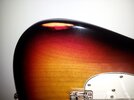There are several myths flying around about nitrocellulose lacquer guitar finishes. Many are simply inaccurate, others are outright false. I'll start with the worst ones.
1)"Nitro is made from wood so it allows the wood to breathe and resonate naturally, improving the tone." This statement is generally false. Nitrocellulose is made from cellulose, which is also what wood is made of. The manufacure of nitrocellulose rarely uses cellulse, or plant cell material, from trees, but rather cotton which is much more easily nitrated. But that's not the worst part of this statement. Saying Nitrocellulose allows wood to "breathe" because it's manufactured from similar raw material is about like saying you should be able to breathe water because it's 80% oxygen by weight and you breathe oxygen. Nitrocellulose lacquer paints were in fact developed by DuPont in the 1920's specifically NOT to breathe, but to be a sealant against the forces of nature for automotive applications.
I'm not saying Nitrocellulose Lacquer finishes aren't good finishes, and aren't good for a guitar's tone, but they DON'T allow the wood to "breathe". In fact, the wood in your guitar's body stopped "breathing" within hours of the tree being cut down; it's dead now.
2)"Nitro takes weeks or even months to properly cure." This statement is utterly false. Nitrocellulose lacquers do not cure, but are evaporative finishes, which no matter how long they have been solid can be redissolved in the original solvents. When something cures, it can no longer be dissolved in it's original solvents, like epoxy or concrete, although you may be able to dissolve it in acid. To test this, splash some lacquer thinner on your friend's mint 1957 Stratocaster. No don't: he'd probably sue you. Lacquers dry to the touch relatively quickly, but then take weeks, or even months to dry completely, leading to the misconception that they "cure".
3)"Nitro will improve the tone of your guitar." This statement is misleading. If you were to take that 80's polyester finished electric guitar and spray nitrocellulose lacquer on top of it, nothing will improve whatsoever. What makes nitro a good finish is that it is very thin, so it does less to get in the way of the natural vibrations of the wood, which imparts a more full tone than a thick polyester finish.
The fact is that Nitro is a good guitar finish, and it's what was used back in the 50's and 60's. From the early 70's in to the 90's thick polyester finishes were the norm, which do sound somewhat "dead" and "lifeless" when compared to older nitro finishes. The advantage that they had was that they were very durable and shiny. Most of today's better intruments use a very thin polyurethane finish that sounds much closer to an older nitro finish than the thick polyester finishes, while still being very durable.
The real truth is that the finish on an electric guitar will only play a very small role in the overall tone. The pickups, bridge, neck wood, neck thickness, nut material, body wood, body shape, string guage and the player himself will each have at least as much to do with the tone as the finish, if not considerably more. What's more is that it isn't what nitro is made of that makes it a good finish, it's just that it's very thin, especially when compared to it's direct replacement polyester and allows the guitar's body to resonate more, giving slightly more fullness and depth to the tone.
What's bad about nitrocellulose lacquers is that they are very toxic, and have in fact been outlawed for use as an automotive finish throughout most, if not all, of the United States even by auto refinishers for that reason. They are still legal as a furniture finish, and can be bought in many states for that purpose.
But there is nothing magical about Nitro. A thin acrylic lacquer finish will be basically indistinguishable from nitro except that it won't yellow and crack over time. Oil finishes such as linseed or tung oil will resonate just as much, if not more, and can be very beautiful espcially when used in conjunction with a stain. Thin modern polyurethane finishes do not hinder tone nearly as much as the older polyester finishes and are much, much more resitant to chipping and scratching than nitrocellulose, and in fact, when used on a guitar with a high quality neck and bridge, high quality pickups, etc ... will have a superior tone to a guitar with a nitro finish and a cheap neck, bridge and pickups.







